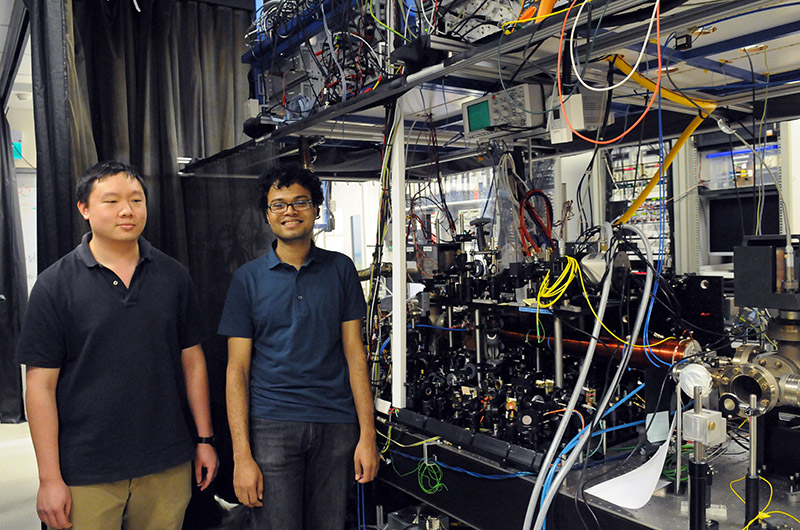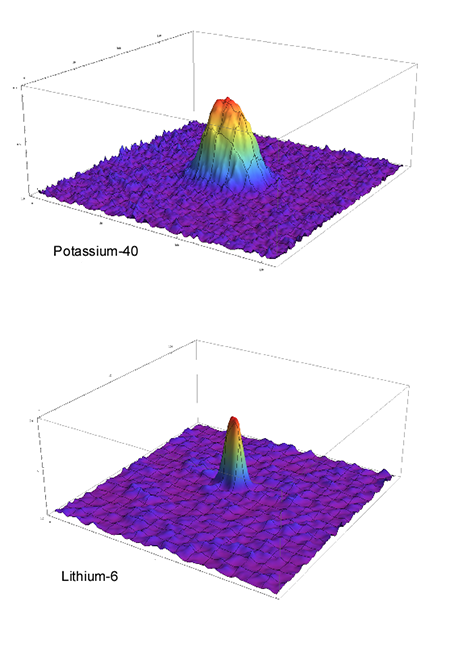Highlights
New at CQT: cold fermions!

CQT PhD students Mark Lam (left) and Sambit Pal (right) have mastered the setup they stand beside to produce a 'triple degeneracy' of cold atoms. They are working on the Fermi mixture project led by Principal Investigator Kai Dieckmann.
The saying goes that when the cat's away the mice will play, but when PhD students Sambit Pal and Mark Lam were left behind at the lab, they instead pushed their experiment to a major milestone. The students managed to cool three atom species simultaneously in their experimental setup, a goal the Quantum Matter group has been working towards since 2010. "This milestone is an entry ticket to competitive science at the highest level," says the group leader, Principal Investigator Kai Dieckmann.
Kai was attending a conference in the United States when the students told him on 11 June that they were reliably achieving the 'triple degeneracy': cold rubidium (87Rb) atoms trapped simultaneously with cold potassium (40K) atoms and cold lithium (6Li) atoms. The experimental goal is to study the physics of dipolar molecules formed when 40K pairs with 6Li. "It is a hot topic right now. Initial work was done at Boulder and Innsbruck now groups at MIT, Munich, Paris, and elsewhere have joined the race to demonstrate a successful approaches in their second generation of enhanced setups like ours," says Kai.
Lithium and potassium are a type of atom known as fermions, and rubidium is a boson. This difference in classification, arising from the quantum 'spin' of the atom, means that lithium and potassium are much harder to cool than rubidium. In the 'Fermi-Fermi mixture' experiment, the Rb is cooled first and then helps to cool the two fermions. All are cooled to a temperature of around 500nK, when they are described as 'degenerate', meaning they are in their lowest possible energy state.
In practice, this means that the atoms' motion has been almost brought to a standstill. Absolute zero temperature, 0K, represents the temperature at which all motion would have ceased. Atoms at room temperature move at hundreds of metres per second. At the nano-Kelvin temperatures achieved in the experiment, the atoms are moving only at millimeters per second.

These plots shows early experimental data mapping the trapped fermions. The atom clouds are detected by 'absorption imaging': a laser beam is shone through the cloud towards a camera, and because the atoms scatter light, the atom cloud creates a shadow that is darkest where the atoms are densest. The plots are three-dimensional representations of the darkness of the shadow. The two clouds of lithium and postassium atoms are located in the same place but imaged separately, milliseconds apart.
These cold, slow atoms form a small cloud about 0.2mm in diameter, which floats inside a vacuum in a steel chamber. The atoms are held in place by electromagnetic fields in a magneto-optical trap (MOT), where Sambit and Mark can image them. The images confirm the triple degeneracy and allow them to estimate the number of atoms trapped. They can now achieve more than 100,000 atoms each of Rubidium and Potassium, and approaching 100,000 Lithium atoms.
The team will now try to increase the atom numbers to reach the team's science goal of studying dipolar molecules, they will also work with Research Fellow Johannes Gambari to implement a step known as 'Stimulated Raman Adiabatic Passage' using CQT's optical frequency comb.
"It is too early for celebration," says Sambit, "but we've got it and we've got it reliably".
The 'reliably' is crucial. The team first achieved triple degeneracy last year but it proved to be short-lived. After a few successful runs, most of the cold Li atoms went missing. The graduate students spent months tweaking the setup: they adjusted lasers (the optics for the setup cover two large tables), timings and temperatures. This was very helpful for learning the ins and outs of the setup, but it didn't reveal the source of the problem. "We were a bit frustrated," recalls Sambit. Eventually, having ruled out everything else, they opened up the vacuum chamber to see what was happening inside. This is the last thing you want to check, because once the chamber is opened, the whole system will have to be cleaned by 'baking' it for three weeks before the air is pumped out and the experiments can begin again.
But once the setup was opened, recalls Sambit, "We were kind of happy: we had found the culprit. The lithium oven was in a completely messed up state." A small oven vapourises the lithium which is then sent through tubing into the MOT. Something, perhaps a poorly controlled heating element, had led to the lithium reacting with the tubing and it becoming blocked. The team was surprised to find it in such bad shape because some atoms had still been making it through. Now, with the parts replaced and the problem fixed, the experiment is back on track.
"The graduate students have mastered an advanced experimental setup that was running in a competitive field before" says Kai. He moved parts of the experiment to Singapore from his former laboratory at the Ludwig-Maximilians-University of Munich, Germany. "The circumstances were difficult because nobody moved along from Germany. Special credit should go to Sambit and Mark who are on a steep learning curve and are hard working. Now this first generation of students is on top of things, the usual passing on of information between the generations of graduate students on a working setup should make work much easier in the future."
Find more about the group's research on their webpage: http://qmatter.quantumlah.org.






